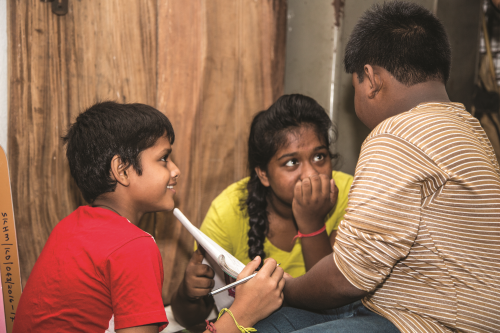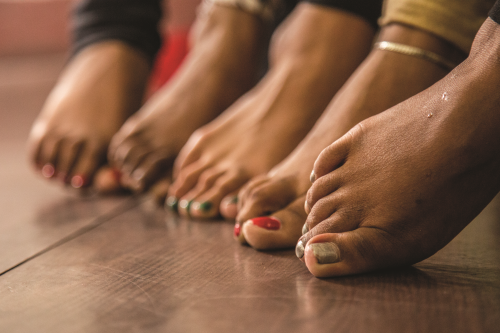
An Indian red light area:
Indian red light areas bear no territorial and/or social distinction between public (work) and private (family) spaces. A red light community is an isolated society and a microcosm within itself. In it, the main trade (of prostitution) and tertiary trades are carried out within the confines of a building that serves both as a brothel (public) and as private homes for women (and families) working in that brothel. Tertiary trades include money-making actions such as renting out half-rooms and/or full rooms for the purpose of prostitution; manufacture / selling / delivery of locally-made alcohol; gambling (lotto) dens; marijuana and/or substance dens; babysitting for mothers at work at a per hour basis (bachha dhora); running “pice hotels” (named after a former monetary unit of India) for clients and people of the community; etc. Generations of women live in brothels in single rooms which are rather generously called “ghor” (home).
Whether retired or still in business, a woman and her immediate and/or extended family co-habit these tiny spaces which are used for work (again be it the flesh and/or tertiary trades), along with cooking, maintaining minimum hygiene (rooms with drains in them double-up as bathrooms for babies/toddlers and menstruating girls), study areas, sleep and relaxation, and entertainment (TV), etc. In short, multiple family members co-exist in single-roomed ghor (read: home) within brothels where they cook, eat, relax / sleep and entertain clients all at the same time. This microcosm within the mainstream has a variety of households involved in various trades that play a major to a minor role in maintaining its socio-economic structure. It is a self-sustaining model. There are several job options even if two-thirds of them are illegal or put its workers at-risk. It is the very reason why even if it is cut-off from the mainstream, a red light area manages to thrive on its own—in fact it thrives better on its own.
Children in the red light area:
Children growing up within such areas, too, are cut off from the mainstream. They exist in a society that works on its own principles and emanating rules of conduct. One of the main rules of such a society is that of violence. Violence in its many forms is the chief and sometimes the only mechanism through which a girl / woman is kept within confines of her “work” by a trafficker / pimp / landlady. Children born out of this violence become a part of this cycle of trauma—right from birth. It is not rare for a child to carry marks—visible or otherwise—of abuse and neglect. In process of recovering from this violence, adolescents and children encounter mental, emotional and/or social difficulties that deter them from being invested in their surroundings, studies and in their lives, to the best of their abilities.
In parts of India prostitution is considered as a main source of family income in the guise of “social traditions”. Women who are in it hail from very poor to poor financial backgrounds. Central Bureau of Investigation (CBI) statement reads, “...studies and surveys sponsored by the Ministry of Women and Child Development estimate that there are about three million prostitutes in the country, of which an estimated 40% are children.” Authorities believe that 90 per cent of human trafficking in India is intra-country. Young people under the age of 18 years comprise at least one-third of people in the flesh trade in cities such as New Delhi, Mumbai and Kolkata. On average, the number of children engaged in prostitution in India increases by at least 30,000 human beings per year. A survey by the Ministry of Human Resource and Development reveal that only 4.9 % of the prostitutes in Kolkata were born within the city. In May 2009, CBI also had the following statistics: around 1.2 million children are believed to be involved in prostitution in India. Ashwani Kumar, the then-chief of CBI, said at an anti-human-trafficking seminar that India occupied a “unique” position—a nation that is a source, transit and destination point for this trade. It is estimated that there are around a 100-million people involved in human trafficking in India. The number of trafficked human beings is difficult to determine due to the secrecy and clandestine nature of the crime. Prostitution and trafficking are intertwined. It may take up to 15 years for girls held in prostitution via the “debt-bondage” process to purchase their “freedom” (Freidman, 1996). Even very young children do not escape the bondage. In fact children are the easiest preys. Root causes of prostitution are poverty and illiteracy: lack of education / information and money lead to a life in risky environments, a childhood stolen, and shameless violations of basic human rights.
Given the facts, the most at-risk and vulnerable, are the children of prostitutes themselves. As mothers work, children loiter around and are exploited especially by visiting clients and passers-by. Besides, when a brothel gets raided and women are arrested, children are left with pimps or brothel owners. Children of prostitutes are the worst sufferers of the trade. They are alienated from basic entitlements; such as uninterrupted education, holistic health and nutrition and strong hygiene. This environment leads to traumas and prevents growth as wholesome / holistic human beings.
Why we do what we do:
South Kolkata Hamari Muskan (a.k.a. Muskan or SKHM) is the idea of social development worker Srabani Sarkar Neogi who has 30 (plus) years of experience working alongside women in prostitution, and young people growing up within the red light community and near railway stations as well as street children. During her years in the field Srabani was troubled by the lack of safety among children and youths growing up in the red light area—especially as their mothers worked. Srabani’s experience also showed her that at-risk children faced abuse from the very persons they got to meet every day (clients, pimp or brothel-owners) leading to emotional scars that often took a lifetime to heal. While mothers worked, children were driven out of homes—day or night. This lack of safe space made children more vulnerable to incidents of abuse (physical, verbal, sexual & emotional) & neglect. The lack of space also meant an invasion of privacy—especially for young-adult females—which led to physical & emotional ill-health. Even while they were at home, menstruating girls found it especially hard to cope with basic, daily hygiene rituals; since within red light areas, space comes at a premium and most rooms or even floors of buildings with several ghor on each floor do not have private and/or attached bathroom.
Several organizations working within this field recognize that women within the red light area display symptoms similar to PTSD; yet not enough is said about the mental health status of children who are born into brothels or stay within the red light area. Srabani wished to address this gap in the provision of mental health services in this particular section of the society.
WHAT WE DO
SKHM’s primary task is to provide children, youths and mothers safe spaces with basic amenities (attached, clean bathrooms—accessible and potable water). SKHM’s aim is care and protection of its stakeholders within those safe spaces. Through this action, we serve as gate-keepers and/or a barrier between the reality of the red light area and our stakeholders. Through several activities integrated within our programs we give stakeholders tools that make them resilient enough to say NO to prostitution and/or work that risks their lives and mental well-being.
SKHM provides education and/or age-appropriate skill-based training combined with psychosocial interventions so that resilience is created to face—and if needs must—fight the ground reality. Our job is to help any individual seeking to exit any harmful trade through relevant skill-based training and then linking them to alternative livelihood methods.
And, SKHM chooses to do all this right in the middle of the red light area because the only way sustainable social change may happen is when children growing up to be adults within the red light area demand a better life for themselves, and generations after, rather than have others hand it to them. We being frontline is our greatest challenge and our biggest advantage.
SKHM is also a rights-based and program-based initiative. Being rights-based means that not only we hold our stakeholder’s rights as sacrosanct but that of our staff’s too. We are a participatory organisation; decisions are democratically taken by staff and stakeholders alike. We are an anti-human trafficking organisation. Our activities can be bundled under four programs (Pampers, Nurture, Breakthrough and Dignity).
SKHM runs six SAFE centres; three in Bowbazar’s Haadkata Gully and three in Sonagachhi (touted as Asia’s densest red light area). Safe Centres are also educational centres that start as early as 10.30am and go on till late in the night (11pm for the oldest centre and 7pm for the youngest). Imagine a single-room holding an entire school; several skill-building resource centres; and mental-health clinics and kitchens filled with people who are closer than family; that’s what we are.
All educational interventions are supported by psychosocial interventions that start as early as 1 year with the Play Therapy Method. SKHM’s focus is to help heal emotional scars. Then take every child to a mainstream school or any youth or adult (whether literate or not) to a certified training school or institute: to encourage learning through doing. The base of education is to enhance a child’s interest to explore and excel on personal skills and competencies. Over time, we have started life-skill, leadership, livelihood-training and resilience-building programs for youths and adults of the community as well. By creating a strong women’s group, SKHM ensures a continuity of education and prevention of second-generation prostitution.
SKHM started work in Bowbazaar in October 2009. On March 4, 2010, it was formally registered as a “Not-for-Profit” organisation under Registration of Societies West Bengal Act XXVI of 1961. When it started its day-care learning centre-cum-crèche on November 2009, there were 16 (+) regular students. Today we work with approximately 210 (+) students.
